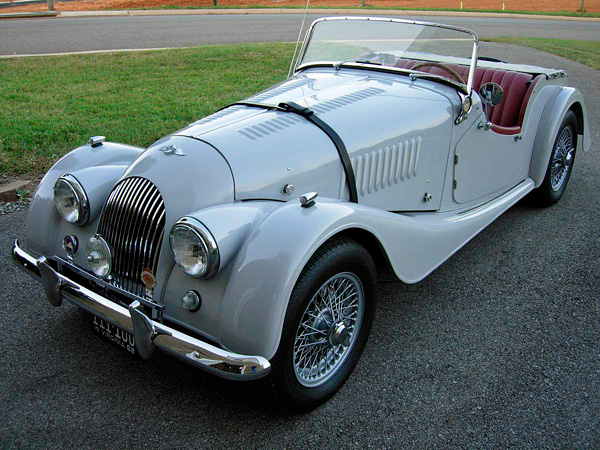 Mikuni Carburetors On a
1962 Morgan Plus 4 With Triumph TR 3 Engine
Mikuni Carburetors On a
1962 Morgan Plus 4 With Triumph TR 3 Engine Mikuni Carburetors On a
1962 Morgan Plus 4 With Triumph TR 3 Engine
Mikuni Carburetors On a
1962 Morgan Plus 4 With Triumph TR 3 Engine
The SU carburetors mounted on vintage British cars used technology that is now over fifty years old. It seems reasonable that a carburetor using modern technology should outperform these much older designs. If you enjoy driving your vintage car that used SU carburetors and are not concerned with originality, a switch to modern technology may be in order. The problem is, carburetors ceased to be used on automobiles when fuel injection became the norm. Motor cycles however continued to use carburetors and new technology continued to be developed. One such carburetor is the Mikuni HSR series.
After stumbling on to the web site of a
company called “Vintage Performance Developments”
I
became interested in trying the Mikuni HSR’s on my 1962 Morgan Plus
4. This company seems to have done a lot of research and development
on these carburetors in order to adapt them to work as a substitute
for SU carburetors. Although I am Mikuni Conversion Morgan/Triumphs an amateur car tinkerer, an
inspection of these carbs indicated to me that they are a quality
built product. As a bonus they are advertised to be able to handle
the ethanol laced gasoline we are now burdened with and not
self-destruct all the gaskets and seals. “Moss Motors”, the
British car parts supplier, is now advertising a Mikuni kit for
MGB’s.
The installation on a Morgan with the TR3 engine is fairly straight forward. The carbs bolt to the stock manifold using the furnished hard rubber adaptors which also act as an insulator to the manifold. The carbs then mount to the adaptors using hose type clips. This is a simple bolt on procedure and can be accomplished in just minutes. The furnished connecter shaft for the two carbs is then cut to the exact length and mounted with the two furnished SU type clips. The furnished kit is not car specific so you must now design hookups for the throttle and chokes.
The Morgan uses a cable system to
operate the throttle with a clamp on the carb throttle shaft at the
front carb. The Mikuni’s come with an extended shaft on each carb
so the operating lever can be mounted on the outer end of either
carb. I mounted the cable lever to the back carb. I then fabricated
an approximately 10 inch flat steel bar and mounted it to a bolt on
the engine bell housing. At the end of this bracket I mounted the
original cable stop to the throttle clamp.
The choke hookup turned out to be more
of a challenge. The original dash mounted choke is one cable which
now must pull on two separate cables. Using flat aluminum sheet I
bent a piece into a squared U shape and one cable is connected to one
flange and the two choke cables to the other flange using cable
stops. The three cables are connected to a common aluminum bar which
can move back and forth. A bracket was made to mount this assembly to
the hood stop on the fender. “Shimano” bicycle brake cables were
cut to the length needed for each cable from the carbs to the flange
on the U bracket. These cables come with a ball end which with a
little filing will fit into the choke plungers.
I had a local British car mechanic help me synchronize and tune the carbs for my application. The carbs are furnished with jets that have been determined to be as close as possible to what the intended engine requires. We found that after driving the car that a one size richer needle jet produced the best results. More power can actually be felt especially at midrange and up throttle position. The on and off throttle response is very smooth and crisp. Starting is easy without using the choke in warm weather and Idle is always consistent. “Vintage performance” claims that they get more power from the Mikuni carbs than either SU’s or Weber’s.
While I am not indorsing specific products or suppliers, I thought it would be of interest to relate my experience installing these carburetors to update an SU installation. Nothing was changed on my car that would prevent the SU carbs form being re-installed.
| WEBMASTER NOTE: Mikuni is a Japanese Company making Carburetors subce 1923. I have used Mikunis for 35 years, albeit on a wide range of snowmobiles producing from 80 to 165bhp. There are none better. |